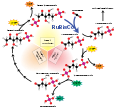Photorespiration (also known as the oxidative photosynthetic carbon cycle or C2 cycle) refers to a process in plant metabolism where the enzyme RuBisCO...
27 KB (3,063 words) - 23:55, 21 May 2024
2) in an interaction called photorespiration, a process that is more prevalent at high temperatures. During photorespiration RuBP combines with O 2 to become...
16 KB (1,456 words) - 16:46, 27 September 2023
reactions of photosynthesis, will increase, causing an increase of photorespiration by the oxygenase activity of ribulose-1,5-bisphosphate carboxylase/oxygenase...
110 KB (11,776 words) - 21:08, 24 October 2024
with O 2 instead of CO 2 in photorespiration. The rate of photorespiration is higher at high temperatures. Photorespiration turns RuBP into 3-PGA and 2-phosphoglycolate...
23 KB (2,772 words) - 15:08, 23 September 2024
the expenditure of energy to recycle through photorespiration. C4 photosynthesis reduces photorespiration by concentrating CO2 around RuBisCO. To enable...
38 KB (4,488 words) - 23:16, 8 May 2024
Photosynthetic efficiency (section Photorespiration)
byproducts via photorespiration, requiring energy and nutrients that would otherwise increase photosynthetic output. In C3 plants photorespiration can consume...
20 KB (2,455 words) - 20:06, 21 August 2024
the net carbon dioxide assimilation is zero. Leaves release CO2 by photorespiration and cellular respiration, but CO2 is also converted into carbohydrate...
10 KB (1,222 words) - 23:56, 17 August 2023
incorporates more oxygen into RuBP as temperatures increase. This leads to photorespiration (also known as the oxidative photosynthetic carbon cycle, or C2 photosynthesis)...
9 KB (1,063 words) - 05:23, 9 February 2024
mechanisms to manage photorespiration, whereas C4 and CAM plants utilize a separate PEP carboxylase enzyme to prevent photorespiration, thus increasing the...
6 KB (660 words) - 17:21, 22 October 2024
has good dissolving properties. Plants produce glycolic acid during photorespiration. It is recycled by conversion to glycine within the peroxisomes and...
13 KB (1,153 words) - 18:14, 19 May 2024
of plants' photorespiration, the labeling of atmosphere by oxygen-18 allows for the measurement of oxygen uptake by the photorespiration pathway. Labeling...
9 KB (1,021 words) - 15:51, 20 May 2024
Atmospheric oxygen competes with this reaction. In a process called photorespiration RuBisCo can also catalyze addition of atmospheric oxygen to the C2...
8 KB (903 words) - 04:56, 23 March 2022
glyoxylate is also an important intermediate in the photorespiration pathway. Photorespiration is a result of the side reaction of RuBisCO with O2 instead...
23 KB (2,297 words) - 22:30, 21 October 2024
process called photorespiration. This is energetically costly as the plant has to use energy to turn the products of photorespiration back into a form...
32 KB (3,704 words) - 22:06, 17 October 2024
RuBisCO which initiates photosynthesis. Furthermore, oxygen stimulates photorespiration which reduces photosynthetic output. These two mechanisms working together...
2 KB (141 words) - 21:41, 19 August 2023
susceptible to attack by oxygen (O2) in the (undesirable) process called photorespiration. Phenols represent a kind of enol. For some phenols and related compounds...
14 KB (1,158 words) - 12:55, 1 November 2024
increase their photosynthetic efficiency by reducing or suppressing photorespiration, which mainly occurs under low atmospheric CO2 concentration, high...
28 KB (2,384 words) - 18:54, 26 June 2024
produced and consumed on a prodigious scale as an intermediate in photorespiration, an undesirable side reaction that competes with photosynthesis. It...
2 KB (128 words) - 23:20, 13 August 2023
fixation pathway for photosynthesis which avoid the losses resulting from photorespiration in the more common C3 carbon fixation pathway. These biochemical strategies...
138 KB (14,773 words) - 09:08, 30 October 2024
Chloroplast (section Photorespiration)
simply be a side effect of another photosynthesis-depressing factor. Photorespiration can occur when the oxygen concentration is too high. RuBisCO cannot...
189 KB (19,141 words) - 15:05, 28 October 2024
oxygen by rapidly diversifying animal faunae and also by plants for photorespiration and their own metabolic needs at night. Breakdown of pyrite and volcanic...
67 KB (6,906 words) - 02:11, 4 November 2024
Carbon respiration Ecosystem respiration Net ecosystem production Photorespiration Soil respiration Carbon pumps Biological pump Martin curve Solubility...
101 KB (10,512 words) - 19:52, 31 October 2024
produce them by photosynthesis. Plant peroxisomes also participate in photorespiration and nitrogen metabolism in root nodules. Graham IA (2008-01-01). "Seed...
2 KB (242 words) - 21:18, 8 June 2024
to excrete excess nitrogen produced by amino acid Catabolism; like photorespiration, the urea cycle had long been considered a waste pathway. However,...
148 KB (15,296 words) - 18:57, 2 November 2024
Phosphoglycolate is recycled through a sequence of reactions called photorespiration, which involves enzymes and cytochromes located in the mitochondria...
59 KB (6,522 words) - 18:16, 20 August 2024
381, PMID 11326045 Sharkey, Thomas (1988), "Estimating the rate of photorespiration in leaves", Physiologia Plantarum, 73 (1): 147–152, doi:10.1111/j.1399-3054...
108 KB (12,426 words) - 04:24, 29 October 2024
involved in photorespiration. Chlorophyte algae use a dehydrogenase inside the mitochondria to process glycolate during photorespiration. In contrast...
48 KB (4,807 words) - 05:48, 5 November 2024
respiration, exchange of gases between plant roots and the atmosphere Photorespiration, enzymatic combination of RuBP with oxygen "Respiration" (song), a...
2 KB (266 words) - 15:20, 2 March 2024
include the glyoxylate cycle in germinating seeds ("glyoxysomes"), photorespiration in leaves, glycolysis in trypanosomes ("glycosomes"), and methanol...
33 KB (3,863 words) - 06:13, 27 July 2024
fixes oxygen to RuBP, wasting energy and carbon in a process called photorespiration. For both of these reasons, RuBisCo needs high carbon dioxide concentrations...
37 KB (4,475 words) - 06:02, 22 October 2024






















